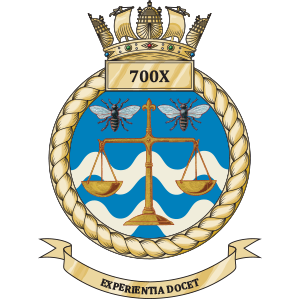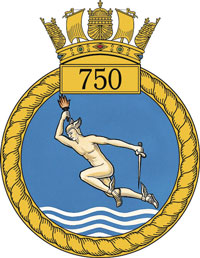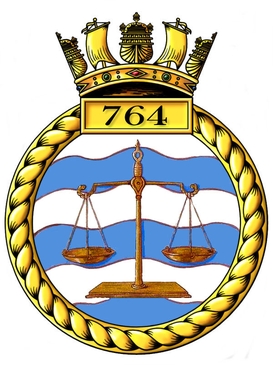
The Fleet Air Arm (FAA) is the naval aviation component of the United Kingdom's Royal Navy (RN). The FAA is one of five RN fighting arms. As of 2023 it is a primarily helicopter force, though also operating the F-35 Lightning II carrier-based stealth fighter jointly with the Royal Air Force.

Royal Naval Air Station Yeovilton, commonly referred to as RNAS Yeovilton, is an airbase of the Royal Navy, sited a few miles north of Yeovil, in the English county of Somerset. It is one of two active Fleet Air Arm bases, the other being RNAS Culdrose. RNAS Yeovilton is currently home to the Royal Navy Wildcat HMA2, along with Army Air Corps Wildcat AH1 helicopters, as well as the Royal Navy's Commando Helicopter Force Merlin HCi3/4/4A and Wildcat AH1 helicopters.

The Grob G 115 is a general aviation fixed-wing aircraft, primarily used for flight training. It is built in Germany by Grob Aircraft. The E variant with a 3-blade variable pitch propeller is in service with the Finnish Air Force, the Royal Navy and Army Air Corps for Flying Grading and in the Royal Air Force as part of No. 6 Flying Training School which provides flying to both University Air Squadrons and Air Experience Flights to Cadets of the Royal Air Force Air Cadets. As of 2020, the Tutor is still being used by the RAF for some Elementary Flying Training (3FTS) but is due to be phased out in favour of its replacement, the more advanced Prefect T1.

Royal Air Force Brawdy, or more simply RAF Brawdy, is a former Royal Air Force satellite station located 6.3 miles (10.1 km) east of St Davids, Pembrokeshire and 9.8 miles (15.8 km) south west of Fishguard, Pembrokeshire, Wales. It was operational between 1944 and 1992; it was used by the Royal Air Force and the Royal Navy (1946–1971), before the site was turned over to the British Army and renamed Cawdor Barracks.

700 Naval Air Squadron is a Maritime Unmanned Air System squadron in the Royal Navy’s Fleet Air Arm. Known as 700X Naval Air Squadron, where the 'X' is used to designate 'experimental', it is currently the Royal Navy's Remotely-piloted air systems (RPAS) or 'drone' expert unit.

848 Naval Air Squadron was a squadron of the Royal Navy Fleet Air Arm. It operated the Westland Sea King HC.4 helicopter and previously provided advanced flying training to pilots for the other squadrons in the Commando Helicopter Force. The squadron was based at RNAS Yeovilton in Somerset and was decommissioned on 24 March 2016.

702 Naval Air Squadron was a Naval Air Squadron of the Royal Navy's Fleet Air Arm which last disbanded in August 2014. It was last based at HMS Heron, RNAS Yeovilton, Somerset and earlier at HMS Osprey, RNAS Portland, Dorset. As a training squadron it trained all ground and air crew for the sister front-line maritime Lynx unit, 815 Naval Air Squadron. It initially formed during July 1936 as a Catapult Flight for the 2nd Battle Squadron based at RAF Mount Batten and routinely embarking in RN ships such as, HMS Nelson, HMS Rodney and HMS Resolution. By 1939 it was known as 702 Naval Air Squadron but disbanded in January 1940.

The Royal Navy Observer School grew out of HM Naval Seaplane Training School at RNAS Lee-on-Solent as a result of a series of changes of identity and parent unit. From 1918 until 1939 the Royal Air Force was responsible for naval aviation, including training and provision of aircrew to the Royal Navy. With the return of naval aviation to the Royal Navy on 24 May 1939, the Observer School was established as 750 Naval Air Squadron of the Fleet Air Arm. During World War II the squadron moved to Trinidad to continue training aircrew. It was temporarily disbanded in October 1945. The squadron reformed in 1952 and is currently based at RNAS Culdrose, where it trains approximately 30 Royal Navy observers every year.
801 Naval Air Squadron (NAS) was a Fleet Air Arm squadron of the Royal Navy formed in 1933 which fought in World War II, the Korean War and the Falklands War.

736 Naval Air Squadron was a Naval Air Squadron of the Royal Navy's Fleet Air Arm. It was most recently recommissioned at HMS Seahawk, RNAS Culdrose in June 2013 to fly the BAE Systems Hawk, mainly in the maritime aggressor role, following the disbandment of the Fleet Requirements and Aircraft Direction Unit (FRADU) and operated up until March 2022. It initially formed as the School of Air Combat in May 1943 at HMS Heron, RNAS Yeovilton. In September 1943 it moved to HMS Vulture, RNAS St Merryn, where it became the Fighter Combat School and it created an independent 'B' Flight for fighter affiliation work between March and September 1945. 736 Naval Air Squadron moved to HMS Seahawk, RNAS Culdrose in February 1950 as the Naval Air Fighter School in the 52nd Training Air Group, but disbanded in August 1952. Immediately the following day, the squadron reformed at HMS Seahawk, RNAS Culdrose out of 702 Naval Air Squadron as an Advanced Jet Flying School and in November 1953 it moved to HMS Fulmar, RNAS Lossiemouth. 736 Naval Air Squadron disbanded there in March 1965, but what was left became 764 Naval Air Squadron ‘B’ Flight. The squadron reformed the same day at Lossiemouth from 809 Naval Air Squadron as a Jet Strike Training Squadron. 1966. In March 1967, its aircraft were part of the group that bombed and set on fire the supertanker SS Torrey Canyon aground and leaking crude oil on Seven Sisters rocks off Cornwall. The squadron disbanded in February 1972.

The Royal Navy Historic Flight (RNHF) was the historic flight of the Fleet Air Arm of the Royal Navy up until its disbandment in March 2019. The RNHF maintained and flew a small number of aircraft that were important to British Naval aviation. The organisation was not part of the military establishment; it had charitable status and was staffed by civilians. It was based at RNAS Yeovilton and provided aircraft for air displays.

703 Naval Air Squadron of the Fleet Air Arm of the Royal Navy was formed as a long-range catapult squadron on 3 March 1942 at RNAS Lee-on-Solent. During the Cold War, it was reformed as an experimental trials unit, and then as a helicopter training squadron. Since 2003, the squadron has formed the Royal Naval wing of the Defence Elementary Flying Training School at RAF Barkston Heath.

759 Naval Air Squadron was a Naval Air Squadron of the Royal Navy's Fleet Air Arm. It was created on November 1, 1939, and was disbanded on December 24, 1969. It was initially intended as a Telegraphist Air Gunner Training Squadron but became a Fighter School and Pool Squadron in 1939, at RNAS Eastleigh. It operated out of RNAS Yeovilton from 1940 to 1946, as part of the Naval Air Fighter School. In 1943 a detachment operated out of RNAS Angle, working with 794 NAS and known as the Naval Air Firing Unit. It was again the Naval Air Fighter School upon reformation in 1951 and disbandment in 1954, firstly at RNAS Culdrose and then moving to RNAS Lossiemouth, in 1953. The squadron reformed again, this time at RNAS Brawdy in 1963, as the Naval Advanced Flying Training School, before finally disbanding in 1969.

764 Naval Air Squadron was a Naval Air Squadron of the Royal Navy's Fleet Air Arm. It initially formed in April 1940, at HMS Daedalus, RNAS Lee-on-Solent, as an Advance Seaplane Training Squadron. The Squadron moved to RAF Pembroke Dock in July 1940, and later to HMS Daedalus II, RNAS Lawrenny Ferry in October 1941 and remaining there until the Squadron disbanded in November 1943. It reformed at HMS Siskin, RNAS Gosport, in February 1944, as the User Trials Unit, however, the squadron was decommissioned for the second time in September 1945. 764 Naval Air Squadron reformed again, at HMS Fulmar, RNAS Lossiemouth, in May 1953, where it became an Advanced Training Unit. It moved to HMS Heron, RNAS Yeovilton, in September 1953, where it received its first jet aircraft. In November 1954 the Squadron disbanded.

765 Naval Air Squadron was a Naval Air Squadron of the Royal Navy's Fleet Air Arm. It formed at RNAS Lee-on-Solent, in May 1939, as a Seaplane School and Pool squadron. The squadron moved to RNAS Sandbanks, in August 1940, where it undertook the Seaplane Flying Training Course Part I. Lieutenant Commander J.B. Wilson was appointed as dual officer in charge of the air base, and Commanding officer of 765 NAS. By the middle of 1943, dedicated Seaplane Training schools ended and the squadron disbanded in the October. 765 NAS reformed at RNAS Charlton Horethorne, in early February 1944, as a Travelling Recording Unit. The squadron moved to RNAS Lee-on-Solent in March, before moving to RNAS Worthy Down on one month later during April, then in May it moved to RNAS Stretton, were it remained during June.

766 Naval Air Squadron was a Naval Air Squadron of the Royal Navy's Fleet Air Arm. It was to have initially formed in 1939 at HMS Daedalus, RNAS Lee-on-Solent, as a Seaplane School, however, it formed at HMS Landrail, RNAS Machrihannish, as a Night ALT Course, in 1942. It moved to HMS Nightjar, RNAS Inskip, in 1943, to become part of No. 1 Naval Operational Training Unit. By 1944, it was operating over 30 Swordfish aircraft, but, during the year, also acquired Firefly aircraft from 1772 NAS, and Sea Hurricane aircraft from 760 NAS. It moved to HMS Merganser, RNAS Rattray, early in 1946, but later that year, moved to HMS Fulmar, RNAS Lossiemouth, where it received Seafire aircraft, along with being Part 1 of the Operational Flying School. By late 1951, Sea Fury trainer aircraft were also added to its varied list of types operated. In 1953, the squadron moved to HMS Seahawk, RNAS Culdrose, where it disbanded in 1954.

767 Naval Air Squadron was a Naval Air Squadron of the Royal Navy's Fleet Air Arm. It was initially formed as a Deck Landing Training Squadron in 1939, when 811 Naval Air Squadron was renumbered 767 Naval Air Squadron, at HMS Merlin, RNAS Donibristle. A detachment went to Hyeres de la Palyvestre in the south of France, enabling training in fairer conditions. While here, the squadron took on an operational mission, with a bombing attack on the Italian port of Genoa. With the fall of France the squadron evacuated to French Algeria, where it split. Part went to Malta, forming 830 Naval Air Squadron, the other part to HMS Ark Royal, with personnel returning to the UK via Gibraltar. The squadron regrouped at HMS Condor, RNAS Arbroath, and moved to the Deck Landing School at HMS Peewit at RNAS East Haven in 1943.

781 Naval Air Squadron was a Naval Air Squadron of the Royal Navy's Fleet Air Arm which disbanded at the end of March 1981. Planned as a Reserve Amphibious Bomber Reconnaissance squadron, it formed as a Communications Unit in March 1940 and operated a large variety of aircraft. It provided a Bristol Beaufighter conversion course which eventually became 798 Naval Air Squadron and also had a ‘B’ Flight at Heathrow and then Heston aerodromes before becoming 701 Naval Air Squadron. After the Allied invasion of Normandy the squadron flew to various Royal Navy units on the continent and established an ‘X’ Flight based in France and then Germany. In July 1945 the squadron disbanded into 782 Naval Air Squadron although the ‘X’ Flight was moved to 799 Naval Air Squadron.

799 Naval Air Squadron was a Naval Air Squadron of the Royal Navy's Fleet Air Arm which last disbanded during August 1952. It initially formed as a Pool Squadron in South Africa during September 1943, sharing Fairey Albacore aircraft with 798 Naval Air Squadron and providing flying time for aircrew prior to front line squadron assignment, disbanding in June 1944. It reformed in July 1945 as a Flying Check and Conversion Refresher Squadron at HMS Daedalus, RNAS Lee-on-Solent. Made up of three distinct flights, two of those operated away from Lee-on-Solent with a flight at HMS Siskin, RNAS Gosport, giving junior officers air experience, and another flight at HMS Dipper providing Supermarine Sea Otter conversion training. By May 1948 the whole unit had moved to HMS Heron, RNAS Yeovilton. In 1951, 799 Naval Air Squadron relocated to RNAS Machrihanish.
1831 Naval Air Squadron was a Naval Air Squadron of the Royal Navy's Fleet Air Arm. The squadron was formed in 1943 in Rhode Island as a fighter squadron, before being disbanded, reformed and disbanded again after its return to Britain in 1946. It saw no combat during the Second World War.






















